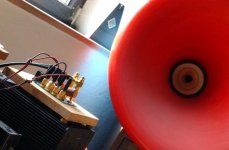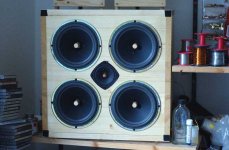I wish to build a gainclone to operate from a single rechargable 12 volt battery indoors.
It will feed Lowther horns and therefore the output of the amp needs to be little more than 2 Watts. I see that BYOB has achieved this but can anyone point me to the right chips and a diagram.
Sound quality is paramount
Thanks
Winnie
It will feed Lowther horns and therefore the output of the amp needs to be little more than 2 Watts. I see that BYOB has achieved this but can anyone point me to the right chips and a diagram.
Sound quality is paramount
Thanks
Winnie
Winnie said:I wish to build a gainclone to operate from a single rechargable 12 volt battery indoors.
It will feed Lowther horns and therefore the output of the amp needs to be little more than 2 Watts. I see that BYOB has achieved this but can anyone point me to the right chips and a diagram.
Sound quality is paramount
If sound quality is paramount, you won't be able to use the chips most gaincloners are using, like LM1875, 3875 and 3886. Minimum required voltage is 20v or +/-10v.
Perhaps a car chip amp might suit your requirements, but battery should have plenty of capacity. At least 10A. But depending on chip, sound quality might be an issue.
Carlos
Variac said:Who is BYOB? any links?
BYOB = Bring Your Own Beer -- at least here stateside
Sorry guys, guess I thought you all knew about BYOB - Bring Your Own Battery (though Beer sounds better
 )
)
http://www.mother-of-tone.com/index.htm
http://www.mother-of-tone.com/index.htm
Texas Instruments are known to work with quite low supply voltages.I wish to build a gainclone to operate from a single rechargable 12 volt battery indoors.
You might wanna check out chips like OPA548 or any other of that series. 549,541...
but is class H.
Class H is not something that I've come across in Hi-Fi. It seems to be a modification of Class AB designed to reduce power consumption.
Any comments on sound quality?
joensd said:
Texas Instruments are known to work with quite low supply voltages.
You might wanna check out chips like OPA548 or any other of that series. 549,541...
TI does nto supply any data on how many watts you will get for lower voltages. They should be just a few for 12 volts.
You will also need to add a large series capacitor at the output, which may impair sound quality. Bridging two chips might be an option to solve that and get more power, but those OPA chips are not cheap.
Carlos
Winnie said:It will feed Lowther horns and therefore the output of the amp needs to be little more than 2 Watts. I see that BYOB has achieved this but can anyone point me to the right chips and a diagram.
Thanks
Winnie
Hi Winnie,,
although I normally would never suggest a transistor amplifier for driving a Lowther speaker, the BYOB works surprisingly well (the tube-o-lator'ed version), which gives evidence to its true quality.
Please note that the BYOBs performance is not only about the parts being used and the battery. It is to a very high degree due to the mechanical design: a flat-mount pcb and amplifier chip, vibrationally coupled to specially treated spruce wood.
So, if you would like to DIY a BYOB amp, you may keep that in mind.
A standard TDA or BB-OPamp circuit driving a Lowther will most likely give you a highly painful experience, as the Lowther really is a very special speaker, and totally allergic to various kinds of solid-state feedback.
I think - In a DIY Way - you may arrive at a much better end-result, if you DIY a 2A3 tube amp for your Lowther speaker instead of a chip-amp.
It's a matter of what matches what and the avoidance of unnecessary problems.
A simple 2A3 amp (with no feedback), even if imperfectly designed, will sound very well with a Lowther speaker. They just fit together.
Happy listening, Charles
Attachments
Hi Winnie;
4 comments:
1. The TDA 2030A MIGHT, MAYBE work with 12V; or, it might not. According to the data sheets, +/-6V is the minimum operating voltage, and extrapolation of the trend line of "power vs supply voltage" makes it look like it's between 1w and 2w into an 8r load (to my eye anyway). Personally, I'd prefer a bit of margin on the supply voltage though.
2. By using a pair of 12V batteries in series you can try out a lot of other chips too. The cost of an extra cell needn't be a killer, and you can just wire 'em up in parallel for recharging. That's the route I would pursue if a chip amp from rechargeable batteries was the design goal, FWIW.
3. If you're willing to forgo batteries and go to valve amplification, a simple 2A3 SET is a cinch and should work well in this app. The SovTek 2A3 won't set you back a bundle (don't believe the "NOS over all" crowd - some new production valves are really quite good), and you could even consider other valves of lesser output power (the 45 comes to mind....). Another possibility would be the 6BM8 for about 2-3 watts, depending on rail voltage, etc.
4. Good luck with whatever you build!!
All the best,
Morse
4 comments:
1. The TDA 2030A MIGHT, MAYBE work with 12V; or, it might not. According to the data sheets, +/-6V is the minimum operating voltage, and extrapolation of the trend line of "power vs supply voltage" makes it look like it's between 1w and 2w into an 8r load (to my eye anyway). Personally, I'd prefer a bit of margin on the supply voltage though.
2. By using a pair of 12V batteries in series you can try out a lot of other chips too. The cost of an extra cell needn't be a killer, and you can just wire 'em up in parallel for recharging. That's the route I would pursue if a chip amp from rechargeable batteries was the design goal, FWIW.
3. If you're willing to forgo batteries and go to valve amplification, a simple 2A3 SET is a cinch and should work well in this app. The SovTek 2A3 won't set you back a bundle (don't believe the "NOS over all" crowd - some new production valves are really quite good), and you could even consider other valves of lesser output power (the 45 comes to mind....). Another possibility would be the 6BM8 for about 2-3 watts, depending on rail voltage, etc.
4. Good luck with whatever you build!!
All the best,
Morse
mrskinny said:As it appears that Charles either has, or knows someone who has a BYOB amp, what chip does it use?
Charles actually is the designer of the BYOB amp, but does not disclose what chip he uses, as he feels, that the sound quality from his amp is determined to a large degree by the mechanical (vibrational) construction.
He also sometimes forgets his signature...
Charles
ALTMANN MICRO MACHINES
http://www.mother-of-tone.com
A standard TDA or BB-OPamp circuit driving a Lowther will most likely give you a highly painful experience, as the Lowther really is a very special speaker, and totally allergic to various kinds of solid-state feedback.
Charles, I have read just about every word on your interesting site including the section on speakers. As the owner of some Goodmans 201's I agree with what you say about speaker drivers.
But which speakers are best suited to the BYOB? I would guess horns or somethng else with a very high efficiency but you don't actually say what your ears have told you or what you use yourself!
Hello,
well, this guy is using a mini-gainclone with TDA7053 chip from Philips on his oris-horns:
http://home.hccnet.nl/r.v.ede/stereo/old/indexblue.html
Maximum output power is a whopping 1.2 Watts into an 8 Ohm load.
The stereo-chip costs only 1,- Eu (http://www.reichelt.de)
I´ve tried the TDA1553Q car chip. Not that bad, but a LM3875 is better...
Carsten
well, this guy is using a mini-gainclone with TDA7053 chip from Philips on his oris-horns:
http://home.hccnet.nl/r.v.ede/stereo/old/indexblue.html
Maximum output power is a whopping 1.2 Watts into an 8 Ohm load.
The stereo-chip costs only 1,- Eu (http://www.reichelt.de)
I´ve tried the TDA1553Q car chip. Not that bad, but a LM3875 is better...
Carsten
Another cheap candidate.....
Hi Winnie;
I did some more looking around at low voltage audio amp chips and here's another candidate (a better one than TDA2030A IMHO): TDA1905. Min voltage req'd is 4V, max power out is 5 whopping watts. Cost per chip is $2.10 ea. from Digikey. I can't comment on the sonic quality of the chip, but it would certainly be cheap enough to buy a couple for experimental use with your battery project, if nothing else.
Good luck and all the best,
Morse
Hi Winnie;
I did some more looking around at low voltage audio amp chips and here's another candidate (a better one than TDA2030A IMHO): TDA1905. Min voltage req'd is 4V, max power out is 5 whopping watts. Cost per chip is $2.10 ea. from Digikey. I can't comment on the sonic quality of the chip, but it would certainly be cheap enough to buy a couple for experimental use with your battery project, if nothing else.
Good luck and all the best,
Morse
Nuuk said:Charles, I have read just about every word on your interesting site including the section on speakers. As the owner of some Goodmans 201's I agree with what you say about speaker drivers.
Hi Nuuk,
thank you for your uplifting comments. The speaker chapter still is unfinished, I would like to add more example pics and drawings so that everything becomes more understandable... I hopefully will be able to complete it this month ...
Nuuk
But which speakers are best suited to the BYOB? I would guess horns or somethng else with a very high efficiency but you don't actually say what your ears have told you or what you use yourself!
I have not yet come upon a speaker that does not decently work with the BYOB amp.
The only problem may arise when you want to listen very loud with very low efficiency and high ohm speakers, as the BYOB gives only about 2x 10W into 8 Ohm.
It supplies however 2 x 20W into 4 Ohm and up to about 2 x 30W into less than 4 Ohm.
But who wants to listen very loud with low efficiency speakers ? Its a contradiction in itself, like entering the Autobahn with a Velosolex.
With more 90dB & up eff. speakers, the BYOB will be more than sufficiently loud, and no other amp has this kind of explosive response, as the battery supplies the current directly and in a non-limited way.
--
I personally like my Lowther/Oris very much, I also like Altec Voice of the Theatre (with Spruce Horn).
I like one-.. to .. two-way systems.
As for building speakers today, its always a trouble to find decent drivers.
Who makes a speaker with non-plasticized paper cone, paper or nomex voice-coil former and a decent magnet structure ? Well, apart from Lowther... nobody. You have to look for old radio speakers, or ... the cheapest chinese speakers you can get -> see pic.
Charles
Attachments
- Status
- This old topic is closed. If you want to reopen this topic, contact a moderator using the "Report Post" button.
- Home
- Amplifiers
- Chip Amps
- Suitable chip for 12 volt indoor supply


